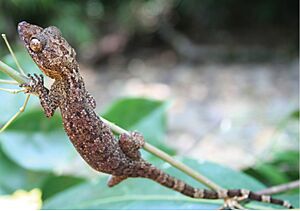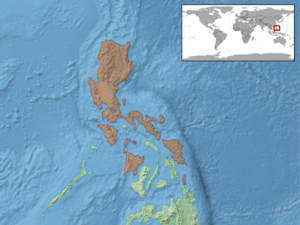Philippine bent-toed gecko facts for kids
Quick facts for kids Philippine bent-toed gecko |
|
|---|---|
 |
|
| This gecko was seen in Palanan, Isabela, Philippines. | |
| Conservation status | |
| Scientific classification | |
| Genus: |
Cyrtodactylus
|
| Species: |
philippinicus
|
 |
|
| Where the Philippine bent-toed gecko lives. | |
| Synonyms | |
|
Gonydactylus philippinicus Steindachner, 1867 |
|
The Cyrtodactylus philippinicus, also known as the Philippine bent-toed gecko or Philippine bow-fingered gecko, is a type of gecko. Geckos are small lizards that belong to the family Gekkonidae. This special gecko gets its name from its unique toes, which look like they are bent or bowed.
Contents
About This Gecko
This gecko was first described by an Austrian scientist named Franz Steindachner in 1867. He named it "philippinicus" because it lives in the Philippines. It is commonly known by its easy-to-remember names: the Philippine bent-toed gecko or the Philippine bow-fingered gecko.
Where It Lives and What It Likes
The Philippine bent-toed gecko can be found all over the northern parts of the Philippines. It likes to live in forests near rivers. These forests are usually found at low to middle elevations, sometimes as high as 800 or 900 meters (about 2,600 to 3,000 feet) above sea level. Some of these geckos have also been found in Indonesia and Malaysia, likely because they were brought there by people.
What It Does at Night
This gecko is a nocturnal animal. This means it is most active at night. During the night, you might spot it on rocks, large boulders, or on tree stumps and logs that hang over water. It also likes to hide or rest among the roots of big trees that are exposed by flowing water.
Its Status in Nature
The Philippine bent-toed gecko is currently listed as a species of "Least Concern" by the IUCN. The IUCN is a group that studies how safe different animal and plant species are. This gecko is considered "Least Concern" because it lives in many places and there are many of them. Its population seems to be stable, meaning its numbers are not going down quickly. However, one of the main threats to this gecko is deforestation, which is when forests are cut down.


